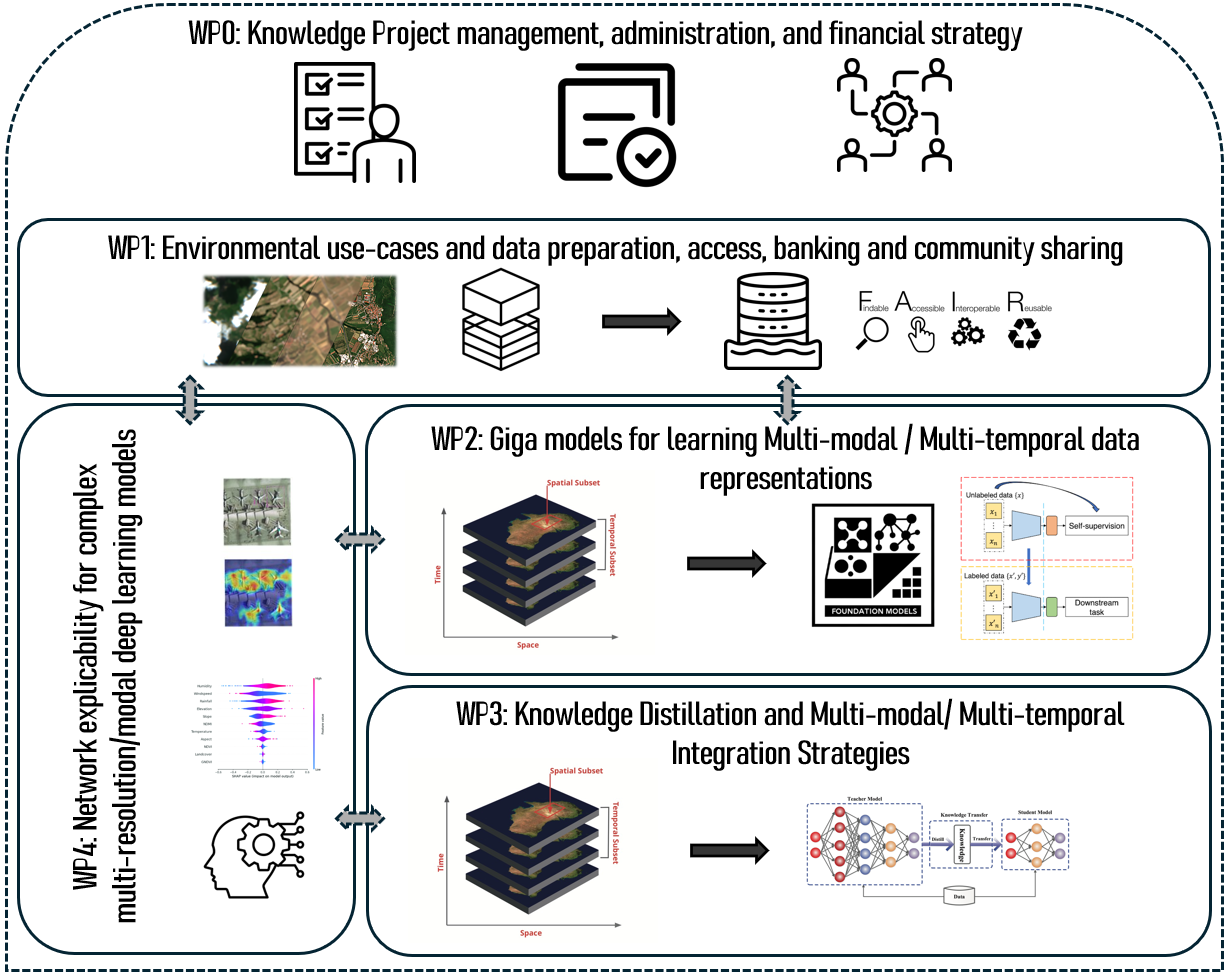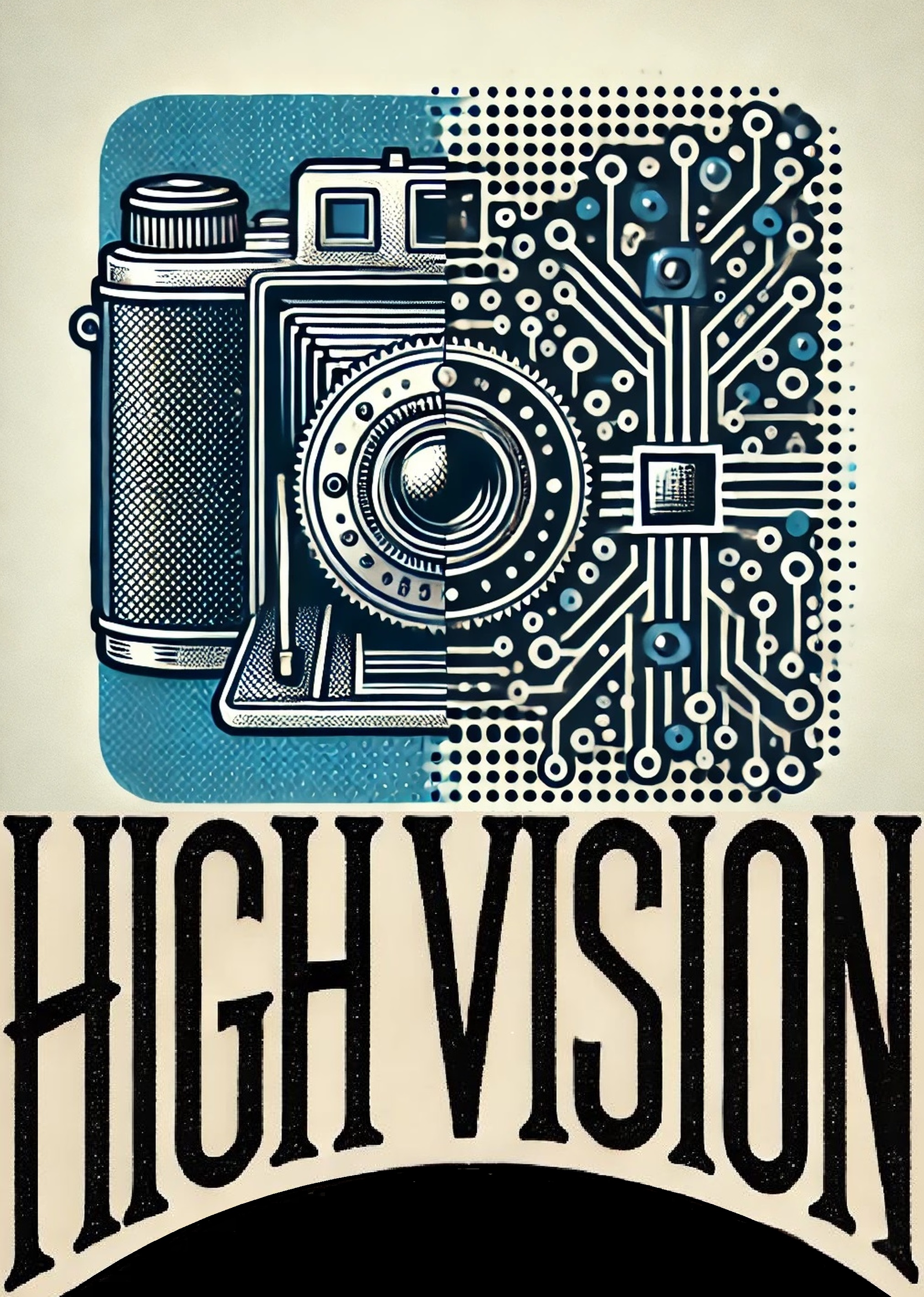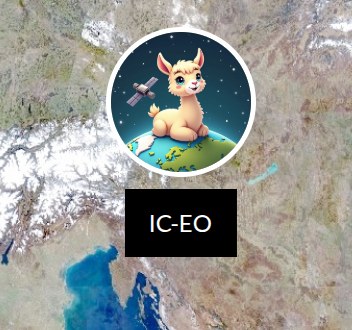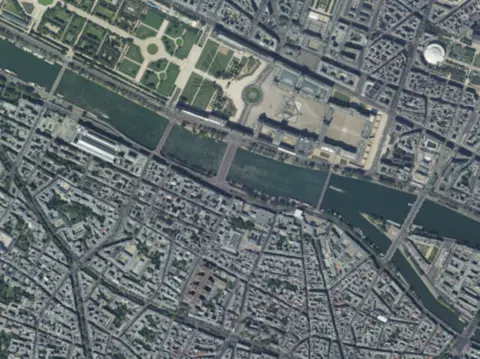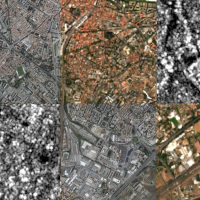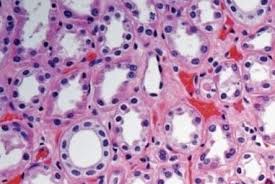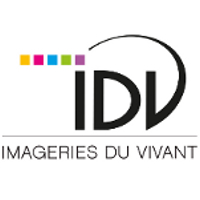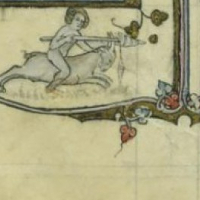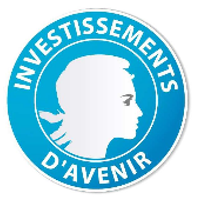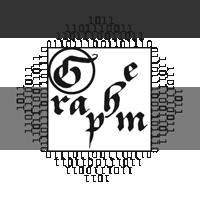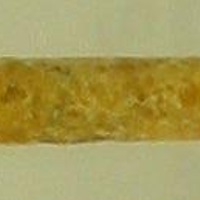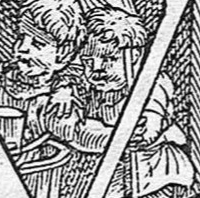Research projects
M2-BDA (ANR PRC): 2025-2028
Partners: LIPADE (Paris), IRIMAS (Mulhouse), LIVE (Strasbourg), ITES (Strasbourg)
Multi-Modal Big Data Analytics: knowledge distillation and deep learning for actionable insights. The goal of M2-BDA is to develop original processing approaches to explore and discover hidden relationships from the combination of diverse types of Earth Observation (in-situ, airborne, satellite, participatory data) multi-modal and multi-scale data. We propose to focus our efforts on learning approaches adapted to massive instrumental data streams, and will concentrate on several key areas: (1) dealing with multi-modal/temporal, and multi-resolution satellite, aerial and in situ data, (2) develop giga-models and self-supervised learning to tackle the lack of labelled data, (3) knowledge distillation to simplify complex models, (4) network explicability to leverage the “black box” of deep learning models for better user understanding. The M2-BDA interdisciplinary project is based on complementary expertise in Computer Sciences (image analysis, pattern recognition, machine learning and data mining and high performance computing) ensured by LIPADE and IRIMAS (in strong collaboration with the HPC of the University of Strasbourg), in environmental geography (land cover/use change analysis) with LIVE and in geoscience with ITES.
View ProjectHighVision (ANR PRC): 2025-2028
Partners: LARCA/LIPADE/Université Paris Cité, LIP6/Sorbonne Université (SU), Maison des Sciences de l’Homme Mondes (UAR 3225), Service Historique de la Défense (SHD), Image Centre (IMC) at Toronto Metropolitan University (TMU).
Computer vision for a history of early news photo agencies at scale. The High-Vision project aims to advance historical investigations and research in computer vision and artificial intelligence (CVAI) for large collections of historical photographs. It seeks to harness state-of-the-art models for AI training data with a view to shape little-curated photographic archives into digital assets so that they can be investigated by historians, archivists, and the public on a large scale and in innovative ways. The objective of this project is to go beyond state-of-the-art developments in computer vision, focusing on layout segmentation as pre-processing steps, object recognition, image similarity and retrieval followed by metadata enrichment to improve the multimodal indexing steps of images from different data corpora. This High-Vision project will establish a robust pipeline that can effectively trace the circulation of news photographs, document their changing editorial contexts and accurately shape a mass of digitised historical photos without pre-existing metadata into a usable collection.
View ProjectGEO IC-EO (ESA - PI: Sylvain Lobry): Since 2024
Partners: LIPADE (Paris), INRIA, INRAE (Montpellier)
The objective of the IC-EO project is to propose a conversational assistant that can interact with EO data, such as images. In this project, we will take advantage of the fact that EO tools can be interfaced via code. This will allow us to propose a model that can integrate current state of the art research in an extensible and straightforward manner. The objective of the IC-EO assistant is to be able to answer such questions as: “How much of the field on the left of this area burned down during the fires last summer?”, and “How many buildings are less than 5 minutes walk from the park?”, without restriction to specific formats. Uniquely, the answer to such questions will be code-based and hence can be reviewed and made comprehensible, as opposed to the black-box nature of current approaches. The model can be decomposed in two parts: first, we propose an application programming interface (API) that encompasses elementary tasks, such as classification, object detection, visual grounding and semantic segmentation. Second, we will train a large-language model to use this API, given as a context, to predict a code-based solution to the user’s query.
View ProjectTAMMI (ANR JCJC - PI: Sylvain Lobry): 2022-2025
Remote sensing images, produced in large quantities, contain information that is already used to monitor climate change, improve security and understand the environment. However, these data are difficult to interpret and often involve manual processing. With the increase in the amount of data, interpretation becomes a limiting factor for the deadlines, but also for the fields in which these can be used. While the data is there, a large audience cannot take advantage of it. As part of the TAMMI project (Text And MultiModal Imagery), our objectives are to facilitate access to the information contained in multimodal data. We propose to use natural language as a way to extract information. For this, we will study shared representations and robustness to missing data. New methods will be proposed to improve the interpretability of predictions made from texts and multimodal data.
View ProjectGEO ReSeT (ANR TSIA - PI: Sylvain Lobry): 2023-2026
Partners: LIPADE (Paris), INRIA, INRAE (Montpellier)
Generalized Earth Observation with Remote Sensing and Text. By using location on the Earth's surface as the common link between different modalities, a geo-spatial foundation model would be able to incorporate a variety of data sources, including remote sensing imagery, textual descriptions of places, and features in maps. Leveraging the large amounts of available unlabeled geo-spatial data from these different sources, the GEO-ReSeT (Generalized Earth Observation with Remote Sensing and Text) ANR project has the objective to learn a better representation of any geo-spatial location and convey a semantic representation of the information. Such a foundation model has the potential to revolutionize Earth observation by allowing for few or zero-shot solutions to classical problems such as land-cover and land-use mapping, target detection, and visual question answering. It will also be useful for a wide range of applications with a geo-spatial component, including environmental monitoring, urban planning and agriculture.
View ProjectAI-COLOPREDICT (INCA-PRTK): 2021-2023
Partners: Centre Georges Francois Leclerc (Dijon), LIPADE (Paris)
The AI-COLOPREDICT project is part of the field of digital pathology, which consists of scanning traditional slides of tissue samples in the form of digital images with very high spatial resolution. Determining the prognosis of localized colorectal cancer remains a major clinical problem. Recently, AI has shown its ability to reveal predictive, prognostic or molecular information from a digitized histology slide. Using several prospective cohorts of stage II and III colon cancers involving more than 3,600 patients, the objectives of the project are to generate and validate prognostic algorithms using deep learning technology to estimate patient survival using a slide stained with hematoxilin eosin saffron (HES), less complex staining to achieve.
View ProjectTIMES (ANR): 2017-2021
Partners: Live (Strasbourg), SERTIT-ICUBE (Strasbourg), MIPH (Mulhouse), Monash (Australia)
The TIMES project aims to support the analysis of satellite image time series in order to monitor the dynamics of our Planet, its land-cover and land-use. The objective of this project is to provide new high-performance processing techniques for mapping and monitoring environmental changes from massive, heterogeneous and high frequency data times series. Our team covers the image processing part of the project, with the main mission of developing and validating novel image analysis methods dedicated to environmental monitoring of landscape objects (e.g. coastal erosion, surface deformation, land cover changes) from the exploitation of the mass of available heterogeneous geospatial data (aerial and satellite images, point cloud data) acquired with very-high temporal frequency. The ANR TIMES project is a collaboration between recognized teams in Computer Sciences (LIPADE, MIPS, MONASH (Australia) and SERTIT-ICUBE), possessing expertise in image analysis, pattern recognition, machine learning and high performance computing, and in environmental geography (land cover/use change analysis) with LIVE and ICUBE-SERTIT.
View ProjectSHADES (ANR): 2014-2018
Partners: L3i (La Rochelle), CEJEP (La Rochelle), FNTC (Paris), Itesoft (Paris)
The SHADES (Semantic Hash for Advanced Document Electronic Signature) project is an interdisciplinary project dealing with the security of documents involving organizations and researchers both from computer science and law domains. The goal is a graphical analysis of digital image documents in view of the change detection. The main lock is building a signed document that is invariant to changes due to the life cycle of a document, but sensitive to a change in the content. This technological study will be completed by a study on the legal position of this technology and its interest for legal professionals. The project will be conducted in collaboration with a trusted third party as end-user.
View ProjectImageries du Vivant (Programme interdisciplinaire USPC): 2014-2017
Partners: Universités Sorbonne Paris Cité
The IDV (Imageries du Vivant ) project is an interdisciplinary project dealing with life imaging in the broad sense. Imaging is the heart of medicine, psychology and biology but requires upstream intake of physics, chemistry and pharmacy and downstream of mathematics and computer signal processing or image obtained for lead to an interpretation to meet the scientific questions raised. The program IDV focuses on: 1) the animation of a interdisciplinary research network bringing together colleagues and teams working on the generation / acquisition / processing / interpretation of biomedical images at Universités Sorbonne Paris Cité, 2) creation of an environment dedicated to the exploitation of large masses of generated image data (big-data) for the development of innovative imaging biomarkers, 3) a reflection on the ethical and legal problems raised by the exploitation of living images.
View ProjectUsages des patrimoines numérisés (Programme interdisciplinaire USPC): 2014-2017
Partners: Universités Sorbonne Paris Cité
The UDPN (Usages des patrimoines numérisés) project is an interdisciplinary project dealing with the uses of digitized heritage. In recent years, extensive digitization of heritage and cultural content is underway. Born in Universités Sorbonne Paris Cité, the UDPN network will study the changes it causes in the practices and representations. In parallel with this proactive scanning, we can not count the work on constraints (technical, economic, legal) are those of content producers. But few interesting reflections in detail to their users and the uses they are doing; when they exist, they concern an area or a particular discipline. By crossing fields of study and disciplinary approaches, UDPN wants: to observe and describe the current changes in practices and performances, to predict their evolution in the form of alternative scenarios, to undertake a methodological reflection to imagine and design instruments for users and their diverse uses.
View ProjectORIFLAMMS (ANR): 2013-2016
Partners: LIRIS (Lyon), ICAR (Lyon), l'IRHT (Paris), l'école des Chartes (Paris), CESCM (Poitiers) and A2iA (Paris)
ORIFLAMMS stands for Ontology Research, Image Features, Letterform Analysis on Multilingual Medieval Scripts. This project aims to study the writings of the Middle Ages and medieval multilingualism in an interdisciplinary and innovative approach. At the meeting of epistemological, scientific, technological, industrial and societal ORIFLAMMS analyzes the evolution of graphics systems and forms of medieval writings according to their production context (usual entries, diplomatic or bookish) and language (Latin or vernacular). It establishes an ontology of forms and graphical analysis of structures of entries to move from a linear approach (textual) a visual approach to answer the questions linguists, historians and researchers paperwork pattern recognition.
View ProjectPiXL (Investissement d'Avenir): 2012-2015
Partners: L3i (La Rochelle), LIRIS (Lyon), Labri (Bordeaux), Itesoft, I2S and Sood
The PiXL project is related to the Investissement d'Avenir, développement de l'économie numérique "technologies de numérisation et de valorisation des contenus culturels, scientifiques et éducatifs". This center of excellence is aimed at establishing a technology park dematerialization and enhancement of digital content from the service of maps and plans of the BNF.
View ProjectSPIRIT (ANR JCJC): 2011-2015
Partners: Lipade (Paris Descartes)
SPIRIT stands for SPatial Interactions In Textures. SPIRIT is a research project at the junction of image processing and cellular biology, gathering several teams around the texture analysis and simulation issues. Texture modeling is a key fundamental research problem in computer vision and graphics systems. It plays an important role in many important medical imaging applications. Some of these medical imaging applications are based on a specific kind of textures, made of a limited number of distinct elements (cell, fiber structure, etc.). These elements are spatially arranged following patterns that often reflect pathological behaviors. The motivation behind this project is to propose texture models that are able to efficiently capture, describe and simulate the relationships existing between the elements in an image.
View ProjectGraphem (ANR): 2008-2010
Partners: LIRIS (Lyon), l'IRHT (Paris), l'école des Chartes (Paris), and LIFO (Orléans)
The GRAPHEM (Grapheme based Retrieval and Analysis for PaleograpHic Expertise of Middle Age manuscripts) project is a multi-disciplinary project that is based on rich medieval manuscripts corpus. It has two ambitions: (1) to contribute to the creation of a true objective and scientific paleography; to create accurate methods for accessing to the contents of these manuscripts, using word-image similarities (Word Spotting, Word Retrieval). (2) The richness and diversity of the writings (of Latin language) will allow us to elaborate and test shape descriptors that will be used in the two applications. A particular caution will be held on the study of graphemes as pieces of strokes holding relevant information.
View ProjectVisavi (ANR): 2008-2010
Partners: L3i (Paris), l'INRA (Tours) et plusieurs entreprises de fabrication d'aliments pour la volaille
The purpose of the Visavi project is control visual and tactile aspects of food (granules), by means of image analysis. These aspects are often challenged to explain the unwanted behavior poultry, yet who reject food with optimal nutritional characteristics. These incidents give rise to significant negative consequences for the animal for the farmer and the feed supplier, with a major degradation of technical and economic performance. The characteristics of shape, texture and color extracted from granules images constitute effective and practical measures to describe their visual and tactile aspects from specialized sensors. Given the complex nature of this problem, its resolution requires the design and modeling of a complex system, whose inputs are the information extracted images of food, as well as those deducted from measures that characterize the eating behavior of the animals.
View ProjectNavidomass (ANR): 2007-2009
Partners: L3i (La Rochelle), LI (Tours), CESR (Tours), LORIA (Nancy), LITIS (Rouen)
Nanidomass stands for "NAVIgation in DOcument MASSes". There is an increasing interest to digitally preserve and provide access to historical document collections residing in libraries, museums and archives. Such archives of old documents are a unique public asset, forming the collective and evolving memory of our societies. Examples are unique manuscripts written by well known scientists, artists or writers; letters, trade forms or official documents that help to reconstruct historical sequences in a given place or time; artwork elements like stamps, illustrations, covers, etc. The challenge that is currently widespread in Europe is the conversion of such heritage to digital libraries that allow to preserve it but also to make it available worldwide using web-based portals. The field of Data Mining, combined with Document Analysis offers a robust methodological basis to perform tasks such as descriptive modeling (clustering and segmentation), classification, discovering patterns and rules or retrieval by content applied to document sources and databases. This ultimate goal consists in developing Pattern Recognition and Image Analysis techniques that allow extracting knowledge from documents and converting them to Digital Libraries containing the scanned pages enriched with semantical information.
View ProjectWaRRIS (ANR JCJC): 2007-2009
Partners: Laboratoire de Mathématiques Appliquées Paris 5 (MAP5) et l'Unité Signaux et Syst\E8mes de l'École Nationale d'Ingénieurs de Tunis
WaRRIS stands for "WAtermarking Réflexif pour le Renforcement des Images et des Sons". The tattoo (or watermarking) is to insert information into a document (sound, image ...) by an imperceptible alteration of the document. While research in this area are often turned to the security objectives (copyright marks insertion), we propose a different approach, guided by a new use of the tattoo. These define intimately related to the host signal tattoos, containing useful information for restoration, analysis or manipulation of the signal at the output of a degraded communication channel.
View ProjectRIAM-REVES (ANR): 2007-2008
Partners: INRIA Rocquencourt
REVES stands for "REal and Virtual Environment System". We hope to set up a research and development in the field of "augmented reality" adapted to the cinema and culture. This technology relates to all processes that the melt virtual real time AV data (3D images) and actual (motion image). The images are projected on different types, interfaces: virtual glasses, virtual box, screen, objects... They make it, immerse it (or them) user (s) (a group of about ten of, actors or visitors) in a visual world composed of real and virtual images. These features of "augmented reality" could find many applications in many markets: culture, the, information, training, video games, the architecture, the communication of company, e-commerce, , sports training, military simulation, ..
View Project